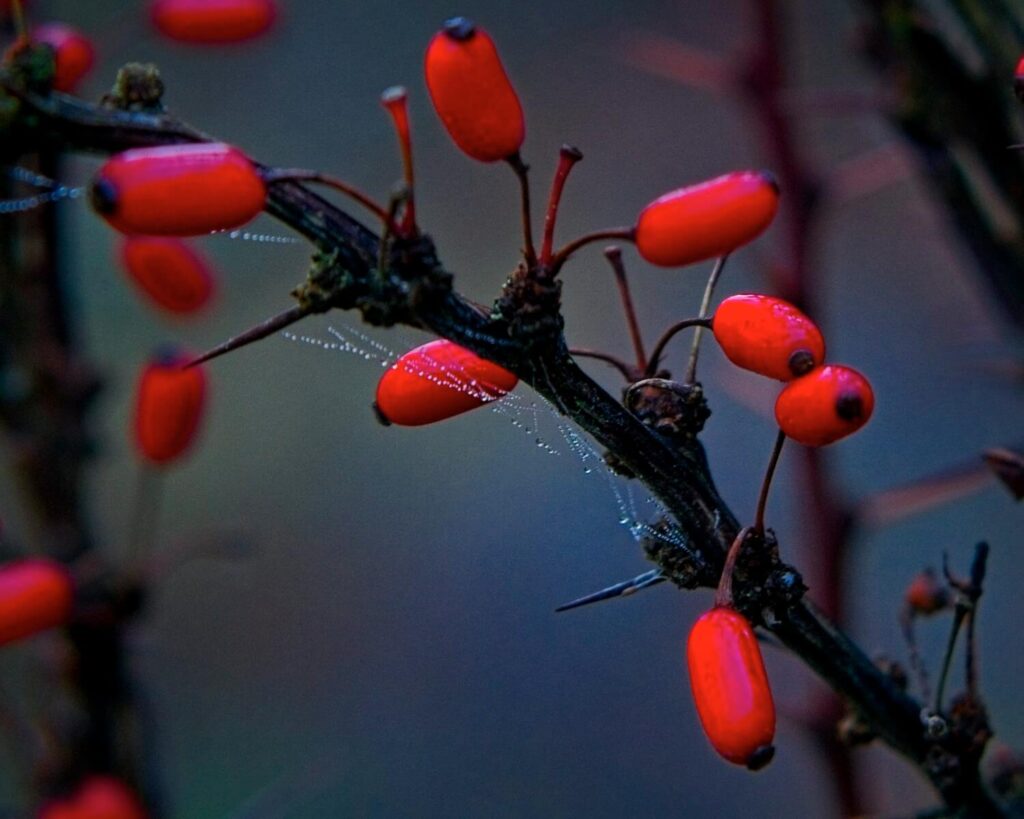
It is mid-December, and I am working outside in a spot of sunshine between rain clouds. It’s a great day for cleaning up the yard, raking leaves, and putting things away before winter. Here in the Pacific Northwest, we learn to take advantage of these moments between weather systems that blow in and out again from off the water. A lot of birds are appreciating the relative calm, too, understanding that this slight breeze is forecast to grow into a gale later this afternoon.
I debate on whether to bother raking the leaves. Every year I pile them into the beds, and every year the wind laughs at me and blows them away. Optimistically, I rake them up again around the old cherry tree that has so generously shed them for me. I also fill a wheelbarrow to dump around a selected shrub or two. Who will be the chosen ones? I have delayed this activity because I wanted to dig up the strangling roots of bindweed first. But at this point, I will have to mulch the ground with cardboard and leaves and call it good. It won’t kill them, but it might at least set them back.

Eradicating this determined terrorist is no longer a possibility. We must find a way to peacefully coexist. I hesitate to make analogies to world affairs, because this is not a political blog. Even so, we all pray for peace. And I, for one, find peace in my garden. Or try to. I recognize my position of privilege.
That said, with that privilege comes responsibility. So, I take this opportunity to clean up the rain-sogged cardboard boxes behind the barn. It looks messy. I’ve been saving these boxes for months for just this purpose. They make particularly good cover when they are wet and follow the contours of the soil.
In picking up a bundle, I uncover a pile of dry grass and fluff woven neatly into a soft ball. Five little mice look up at me in shock. Three dive into the rock pile nearby. One scampers even further under the cardboard boxes. And one, in sheer terror, just stares at me. I have just exposed their winter shelter that they were counting on to survive the cold months ahead.
[I will try to do a drawing of a startled mouse (since I did not get a photo) and will update this post. Stay tuned.]
Update: January 2024. My first attempt at drawing a Deer Mouse (Peromyscus sonoriensis).
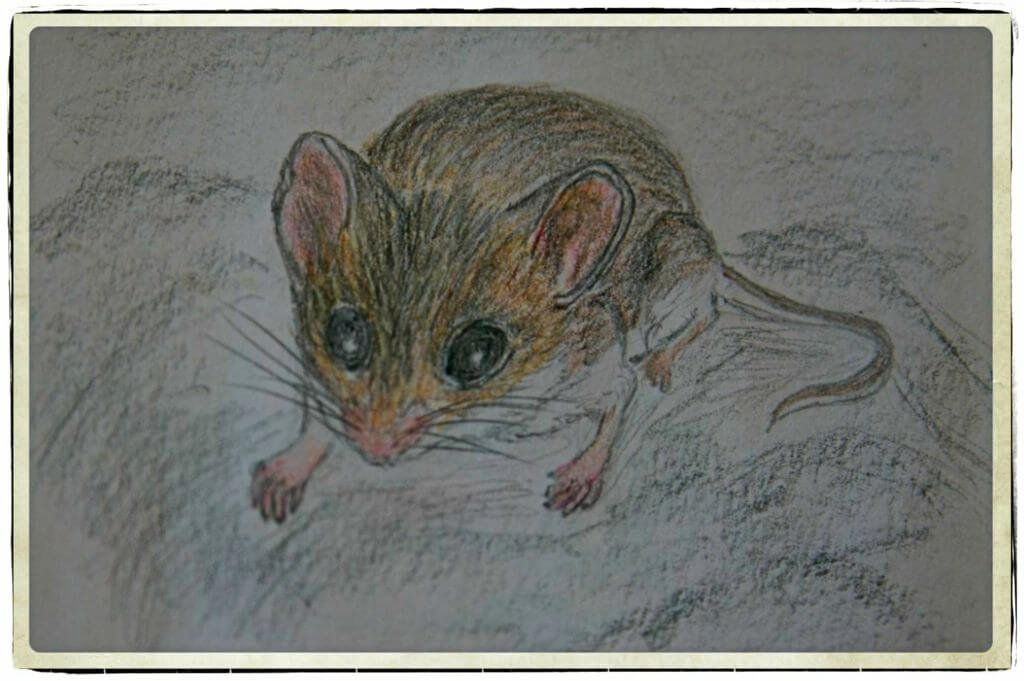
I remind myself: they are mice. They do a lot of damage in my garden. But… they eat insects, which also cause damage. They are food for hawks, coyotes, opossums, and other creatures. They are prolific; these few won’t be missed. But still….
Fine, then. I take time to build them a better shelter, covering their nest with a board that will better keep out the rain and snow than that sagging cardboard box. I put rocks around it to block the gaps and weigh it down with more rocks so the wind does not blow it away. I cannot bring myself to force them to build a new shelter this late in the year.
Now what was I doing? Oh yes. I return to the cherry tree to rake up the leaves. The little Chickadees remind me that the birdfeeder is empty, so first I stop and go get them some bird seed. They stand nearby waiting for me. They must know me by now. It is not long before a jaybird cackles at me from a branch above. How could I forget? The peanuts. OK, OK. I go back to the house for a handful of peanuts and put them down at the base of the tree. Before long, four of them are out there, raucously squawking to one another. They take turns, snatching a peanut and flying away and are soon back for more. I know they have stashed them somewhere.
I have read that they can remember over 40 different places where they hide things, but I question how anyone was able to determine that exactly. These are the Steller’s Jays. The gradation of turquoise blue to black on their feathers is glorious, and their rowdy behavior makes me smile. I have heard they bestow gifts on those who offer food, water, and shelter. I do not know whether I would recognize such a token of gratitude, but it is enough for me that they tolerate my presence so close. That, in itself, is a gift.
So, I go back to raking leaves and trying to decide where to put them. The garden is such a mess. Which shrub is the most needy? Grass is dense and thick everywhere. The deer have shredded the bark of many of the willows with their velvety antlers and have nibbled down the Aronia bushes.
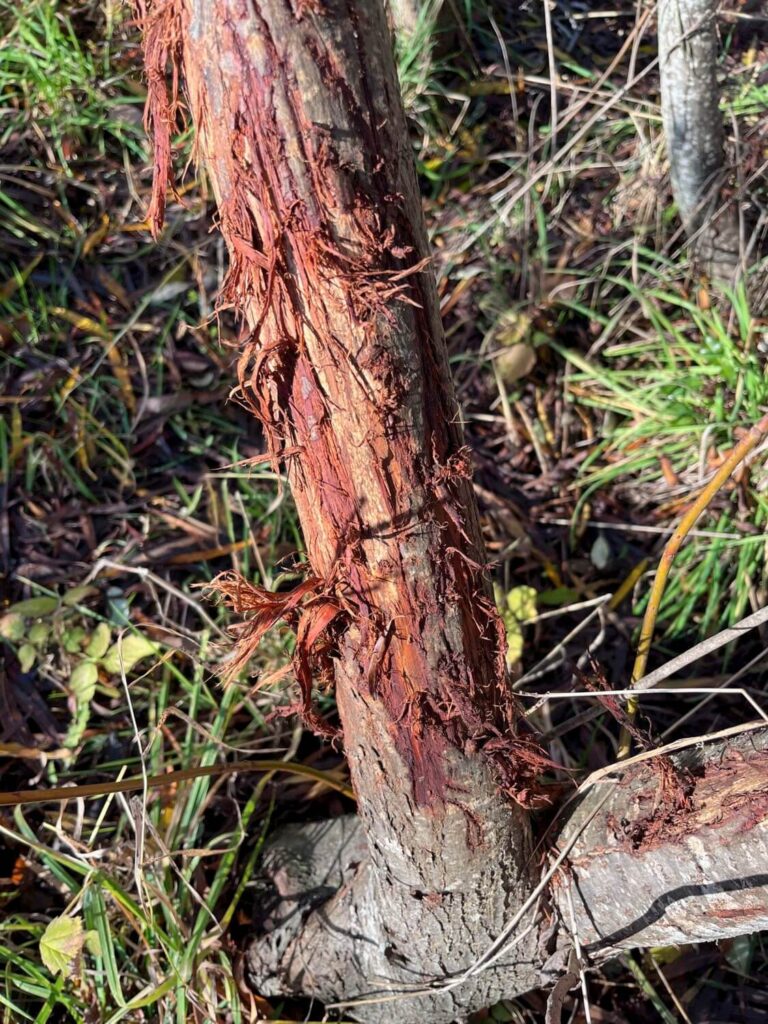
I see a flash of gray and follow it to the willow thicket where a slender Mourning Dove is perched in a tree. A particularly boisterous Jay calls from the other side. Many little birds are flitting and chittering about. The wind is picking up and they all seem to know the weather is moving in. Will I have time to tuck anything in or is it pointless to even try at this point?
The piercing tone of a Varied Thrush interrupts my debate; a swoosh of rusty red-orange flashes overhead. I look for the distinct black crescent around its neck. Perhaps he has been at the Cornelian Cherry where I left numerous deep red droops for hungry travelers such as he.

The young crabapple tree I planted bore fruit for the first time this year, and it, too, has been a feeding station for a variety of birds in its high branches. A Jay flies back into the willows. My guess is this is where he is stashing his peanuts. He surveys the garden from high on a perch. I don’t fool him. He knows I am here trying to stand very still.
The strawberry tree looks like it is dying. Sigh. It has been heavily damaged by deer and morning glory, and the leaves are rusted with some kind of black blight. The branches are doing better on the side with more afternoon sun and wind circulation. But look at this! Flowers and fruit! What else blooms in mid-December? And what else blooms and fruits at the same time on the edge of winter? This makes me happy. I leave these few for the birds; I know where I can forage more if I want them. They provide a winter treat, although a bit gritty tasting. One year I made jam from them. I feel the birds appreciate them more than do my family members, however.


I give it a wheelbarrow of leaves. It truly needs it.
I fought the morning glory a lot this year on the Goumi bushes. The dead vines are covering the higher branches, but I was able to get them off the lower ones. The limbs now reach over the path, creating a bower over the nearby Buddha buddies. They rest in a bowl of Zen sand surrounded by special rocks found in exotic places, but which are now hidden beneath fallen foliage. I sit down on the willow bench and contemplate what it might be like to sit and watch the seasons change, year after year. For a moment, I just breathe, listen, and be.

Despite the Goumi’s many struggles, it produced a lot of fruit this last year, from which I made a wine that will be fun to taste in the months ahead. Tiny buds tell me there will be more leaves in the spring. And now that the leaves are gone, the bare bones reveal – oh my – a bird nest! How did I miss that all year? It was so well hidden!

But I must get moving. I lay down some cardboard and dump some leaves around the Aronia shrubs. After all, this is what I am supposed to be doing out here today, right? I have to stop and wonder, though, how do they even survive my neglect? The deer love their berries, and if I want any, I am going to have to cover their branches. For now, I will just nourish the soil. Perhaps that will help them be strong enough to resist whatever comes their way in the chaos of summer.
I have now wandered out to the edge of the garden where it transitions to a meadow of sorts. It is always such a delight to find fruits and flowers in December, and here in the sinking sun, the Golden Marguerite truly shines. Behind it are some pink yarrows that I do not remember planting, but they seem like friendly companions.

The autumn olives, which were abundant 3 weeks ago, are now gone. Every. Single. One.
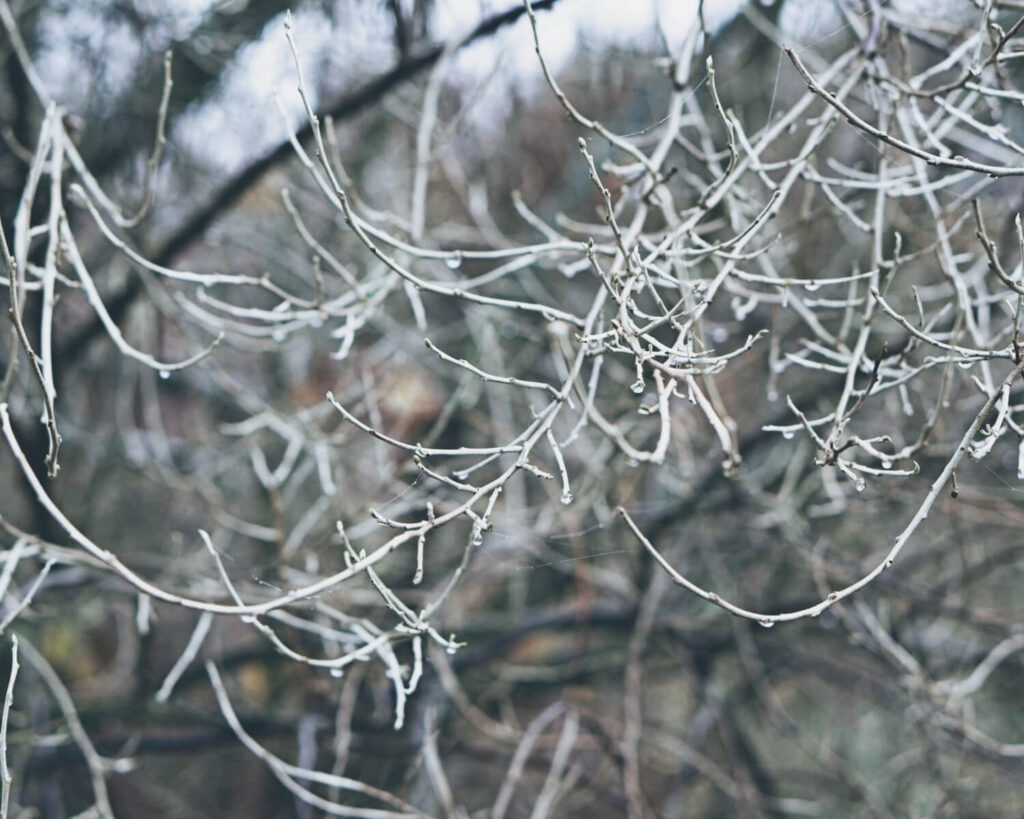
Except this one.
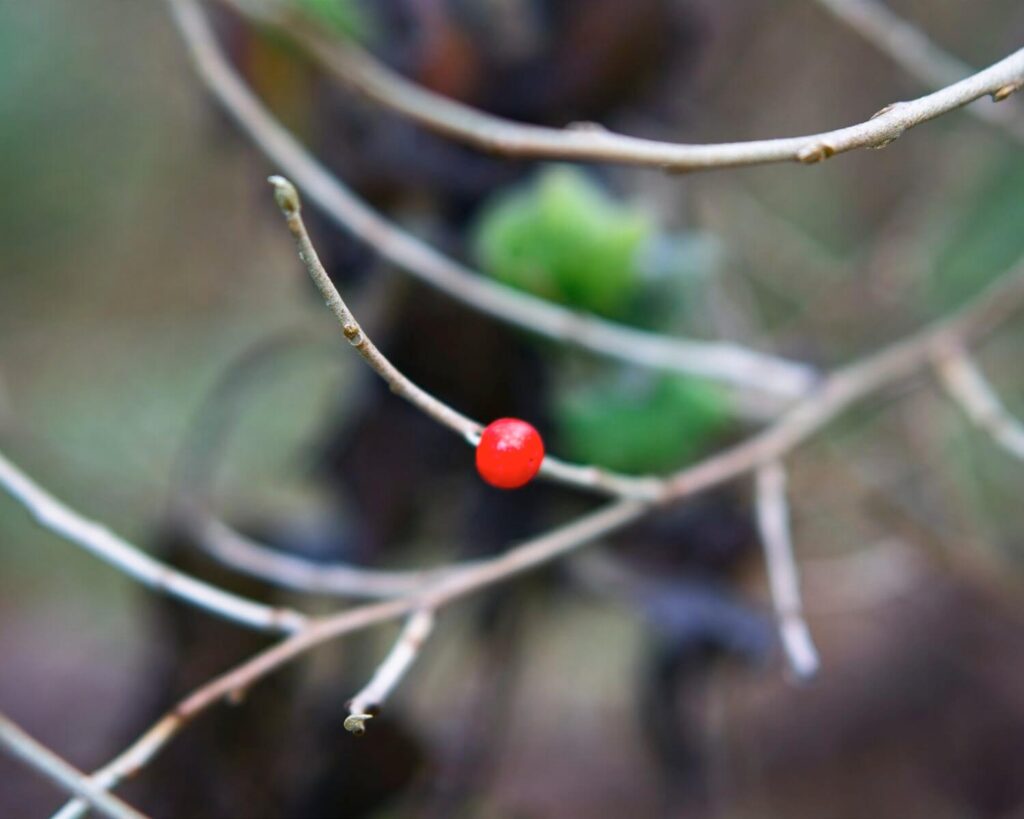
The rose hips are a deep red, some blackened by frost, and all very soft—another good source of food for creatures out there.

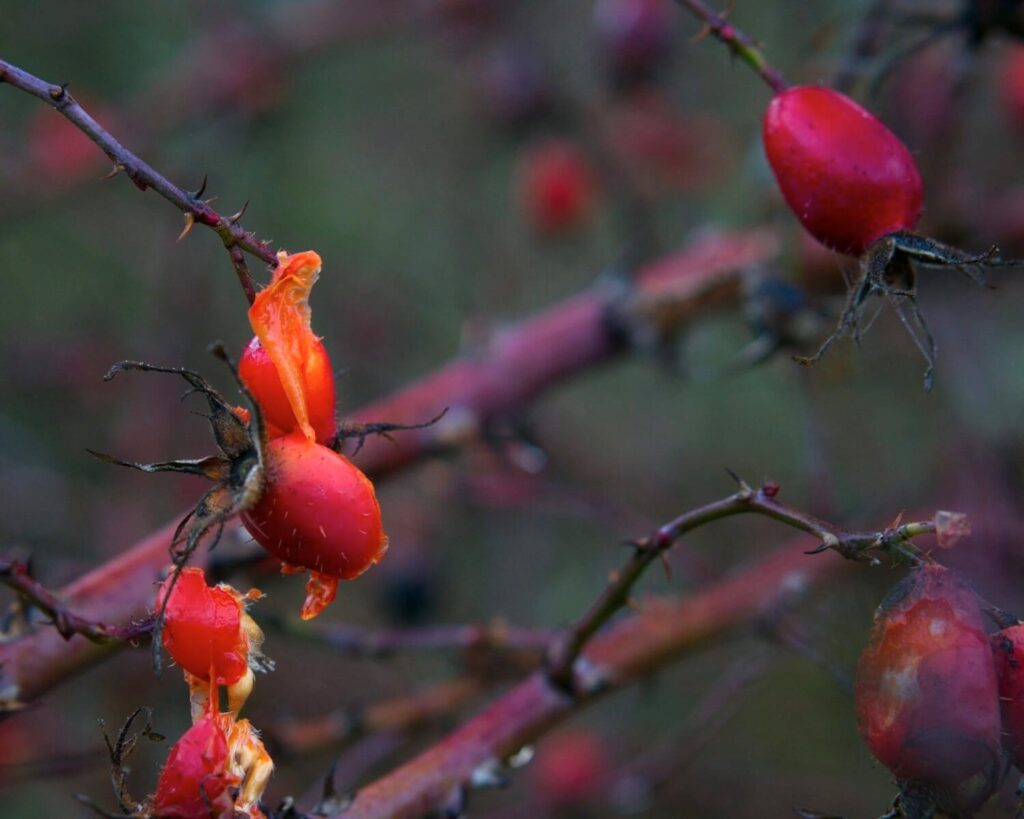
My Jay friend is flying overhead and talking to me—or maybe telling his friends that I’m out here. Going back for more peanuts, I presume.
Ah! Another bird nest! This one in a golden Cornelian Cherry tree. How often I worked around this tree and picked its fruit and never noticed it there!

But there are always birds around when I am out in the garden. There are two fat little Juncos right now, looking at me from the willows, and I think I would grow the willows if for no other reason than that the birds love them. They fly away in a twitter. I cannot take credit for creating this Wonderland full of life. All I did was put a few twigs in the ground.
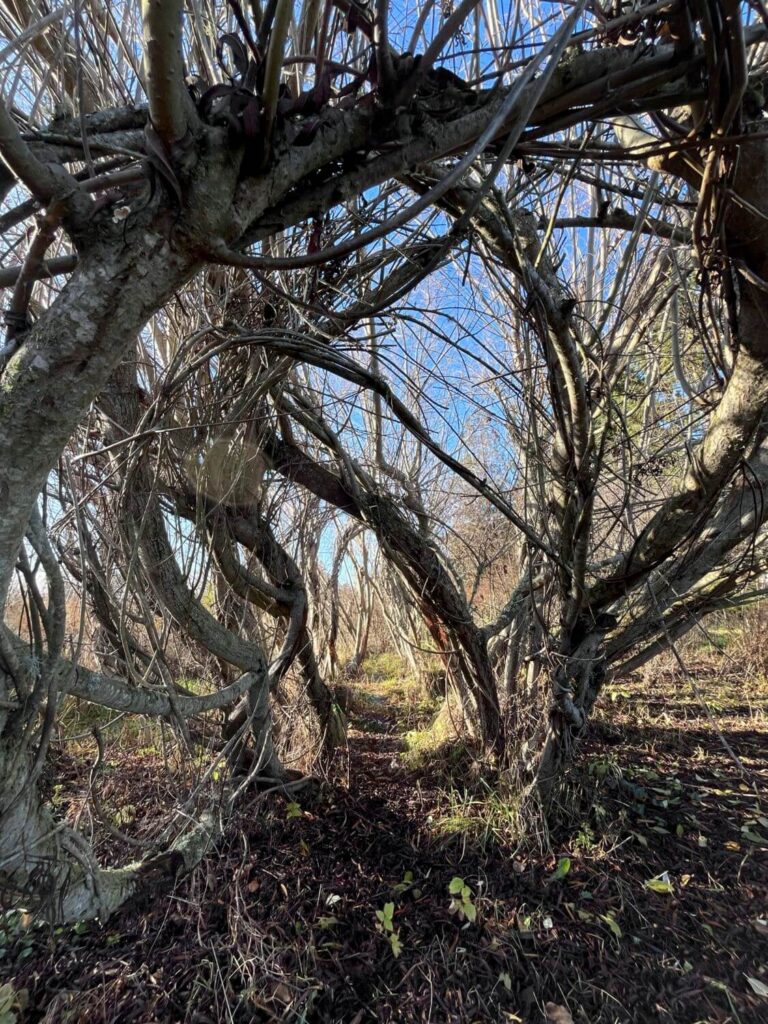
My husband has optimistically hung sheets to dry on the line and I do believe it has been successful. But the wind is picking up its pace now, and I am feeling sprinkles, so perhaps I should attend to them.
I know that I set out to get a lot done today, but somehow I got a little sidetracked. Perhaps I will rake up the leaves tomorrow. And then the wind will blow through again, reminding me of my minisculeness (Is that not a word? It should be.) Eventually, after repeating this a few times, we will build soil. It is a win-win. I get exercise and the satisfaction of knowing I am helping a network of mycelium and at least a zillion microorganisms in the soil; the wind is entertained; the birds and others have a haven of food; the bindweed continues unphased by my curses. Ah well. We can’t win them all.
The sun is low in the sky and the sparrows are quite the chatterboxes. I love being immersed in their conversations. Perhaps it never was about cleaning up the yard anyway. Sometimes it is good to let go of the to-do list and just Be Present.

Enjoy your gardens, everyone – the more wild, chaotic, and messy, the better!

I wish you a Happy Solstice, a Merry Christmas, and much abundance in the New Year!
